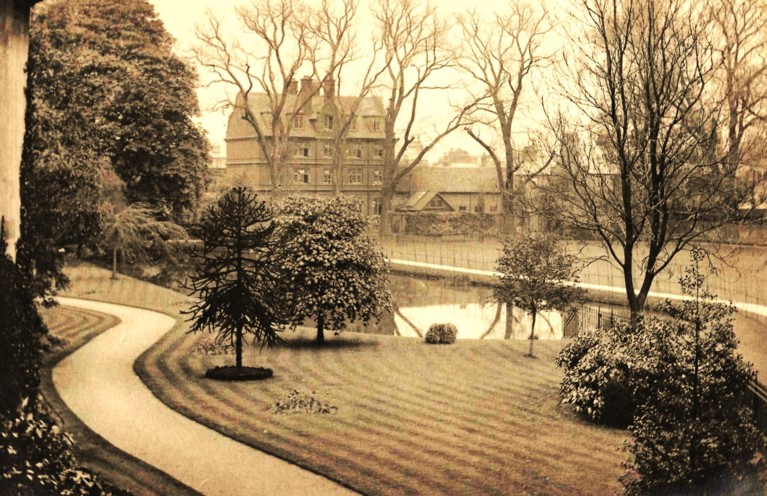Blog
20 December 2023
 View of the College Gardens, 1891
View of the College Gardens, 1891
This intriguing photograph, showing the Paddock under a fairly substantial dusting of snow, bears a one-word endorsement: ‘1891’. It might be supposed, then, that it was taken either in the very cold January of that year, or else in early March, when many parts of England suffered exceptionally severe blizzards. On closer inspection, it is apparent that the photo must date from much later in the year.
For one thing, the striped lawn indicates very recent mowing, which is not a normal feature of winter or early spring horticulture. For another, several circular beds of flowering tulips are visible. The deciduous tree to the left of the pond, moreover, is in full leaf, accompanied by what looks like blossom. A 1937 tree-plan of the college grounds identifies it as a horse chestnut, which normally flowers in May. True, the elms in front of the Hostel are still bare, but that tree comes into leaf rather late.
Meteorological records show that after an extremely warm spell in early May 1891, a sudden and dramatic change in the weather pattern resulted in snow and hailstorms afflicting much of the country on the 17th of that month (Whit Sunday). On the following day, eastern England experienced a particularly heavy fall of snow, some parts of Norfolk having as much as seven inches. A thaw set in within a day or two, so it can be safely assumed that this snowy photo of the Paddock was taken during the Whitsun weekend. The college sporting clubs’ reports in the 1891 Magazine make no mention of the mid-May snowfall, doubtless because of its brevity, but they do record that no rowing or football had been possible for much of January, ‘owing to the long spell of frost’.
The ‘Whitsun’ photographer may well have been Alfred Rose, Emmanuel’s Bursar, who was an enthusiastic amateur snapper. His plate-glass negatives, which are an invaluable visual record of the late-Victorian and Edwardian college, are preserved in the college archives. The photo is evidence that the freak Whitsuntide weather had taken Emmanuel’s residents by surprise, as many of the Hostel windows are wide open. Incidentally, the building adjoining the Hostel was the remaining portion of the straggling range of stables and outbuildings, including a coach house, that had for many years run along the college’s eastern boundary. The single-storey gabled projection is marked as ‘Engine’ on a plan of the college dated 1885, so it was presumably a boiler house; a coal yard was situated nearby. This building and the rest of the outhouses were all demolished in 1893, when the Hostel was extended.
It is interesting to note the steep drop of the ornate iron palings into the western end of the pond. Unlike the railings that ran along the Front Slips, they were not sacrificed to the war effort in the 1940s but remained in situ for another decade. The high fencing beside the path on the right of the pond is probably designed to deflect tennis balls, as the southern part of the Paddock was always marked out for lawn tennis in Easter Term. The protection provided by the fence was no doubt appreciated by the pair of swans that were the pond’s most important residents. The small white shape that can be seen near the pond outfall may be one of these birds. The monkey-puzzle tree, near the chapel, although appearing to be a youngish specimen in 1891, does not appear on the 1937 tree-plan, and the horse-chestnut tree, mentioned earlier, was felled in 1952. The fate of the elms needs no elaboration.
Amanda Goode, College Archivist
